 W
WA hunting dog is a canine that hunts with or for humans. There are several types of hunting dogs developed for various tasks and purposes. The major categories of hunting dogs include hounds, terriers, dachshunds, cur type dogs, and gun dogs. Further divisions can be made among these categories based upon the dogs' skillset and capabilities.
 W
WThe Alaunt is an extinct breed of dog, with the original breed having existed in North Caucasus, Central Asia and Europe from ancient times until the 17th century.
 W
WThe Bull Arab is a type of dog developed in Australia for pig hunting. The dog was developed from crossing large, strong dogs of which the most common were Bull Terriers, Great Danes, Greyhounds, and Mastiffs. The result was a medium to large size, short-haired, muscular dog.
 W
WThe Bully Kutta is a type of large dog that originated in the Indian subcontinent, dating back to the 16th century. The Bully Kutta is a working dog used for hunting and guarding. The type is popular in the Punjab region of India and Pakistan, including Haryana and Delhi, as well as in Tamil Nadu.
 W
WA catch dog is a specially trained dog that is used to catch large animals in hunting, working livestock, and baiting.
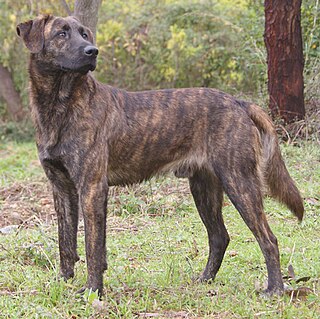 W
WThe Corsican Dog or Cursinu, is a breed of dog originating from Corsica. It has existed on the island since the 16th century, but went into decline during the late 20th century; however it was saved and became recognized by the Société Centrale Canine. Used for a variety of working purposes, it has no specific health issues.
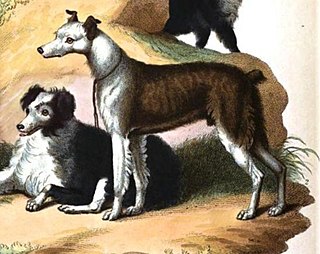 W
WThe term cur is usually used to describe a mongrel dog, particularly of aggressive or unfriendly nature. The term is believed to be derived from the Old Norse kurra, meaning 'to grumble or growl'.
 W
WThe Argentinian Dogo is a large, white, muscular breed of dog that was developed in Argentina primarily for the purpose of big-game hunting, including wild boar. The breeder, Antonio Nores Martínez, also wanted a dog that would exhibit steadfast bravery and willingly protect its human companion. It was first bred in 1928 from the Cordoba Fighting Dog, along with a wide array of other breeds, mainly bulldogs and terriers, including the Great Dane, Dogue de Bordeaux, Pointer, Bull and terrier etc.
 W
WThe East Siberian Laika is a Russian breed of dog of spitz type, a hunting dog originating in parts of Siberia east of the Yenisei River.
 W
WA feist is a small hunting dog, descended from the terriers brought over to the United States by English miners and other working-class immigrants. These terriers probably included crosses between the Smooth Fox Terrier, the Manchester Terrier, and the now-extinct English White Terrier. These dogs were used as ratters, and gambling on their prowess in killing rats was a favorite hobby of their owners. Some of these dogs have been crossed with Greyhounds, Whippets or Italian Greyhounds, and Beagles or other hounds - extending the family to include a larger variety of purpose than the original ratter, or Rat Terrier.
 W
WA foxhound is a type of large hunting hound bred for strong hunting instincts, a keen sense of smell, their bark, energy, drive, and speed. In fox hunting, the foxhound's namesake, packs of foxhounds track quarry, followed—usually on horseback—by the hunters, sometimes for several miles at a stretch; moreover, foxhounds also sometimes guard sheep and houses.
 W
WGun dogs, or bird dogs, are types of hunting dogs developed to assist hunters in finding and retrieving game, usually quail, dove, or duck. Gun dogs are divided into three primary types: retrievers, flushing dogs, and pointing breeds.
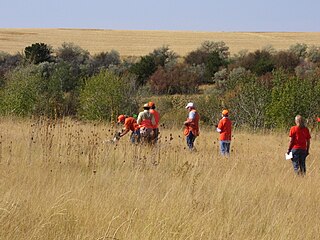 W
WGun dogs are used to hunt all sorts of game. Some are used in the pursuit of big game, although the majority of working gun dogs are used to hunt upland game birds.
 W
WA hound is a type of hunting dog used by hunters to track or chase prey.
 W
WThe Jagdterrier is a type of working terrier, originating in Germany, that is used for hunting quarry both above and underground. This breed of terrier is also called the German Hunt Terrier.
 W
WThe Karelian Bear Dog (Karjalankarhukoira) is a Finnish breed of dog. In its home country, it is regarded as a national treasure. Karelian Bear Dogs will hunt a variety of animals. Its quick reflexes and fearless nature have made it very popular for hunting large game including small black bears, moose, and wild boar. It was the breed's ability to hunt bears that earned the breed its name. The Karelian Bear Dog is among the top 10 most common dog breeds in Finland.
 W
WThe Pudelpointer is a versatile hunting dog breed from Germany. It is a pointing breed that came from a cross between the German hunting poodle (pudel) and the English Pointer.
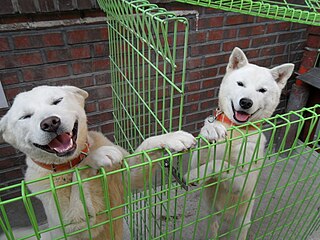 W
WThe Pungsan or Poongsan is a breed of hunting dog from Korea. They were bred in the Kaema highlands of what is now North Korea, and were traditionally used as hunting dogs. The dog is a rare breed, and is sometimes smuggled over the North Korea–China border. The dog was made a national monument of North Korea in April 1956.
 W
WA retriever is a type of gun dog that retrieves game for a hunter. Generally gun dogs are divided into three major classifications: retrievers, flushing spaniels, and pointing breeds. Retrievers were bred primarily to retrieve birds or other prey and return them to the hunter without damage; retrievers are distinguished in that nonslip retrieval is their primary function. As a result, retriever breeds are bred for soft mouths and a great willingness to please, learn, and obey. A soft mouth refers to the willingness of the dog to carry game in its mouth without biting into it. "Hard mouth" is a serious fault in a hunting dog and is very difficult to correct. A hard-mouthed dog renders game unpresentable or at worst inedible.
 W
WThe Russian Tracker or Russian Retriever is an extinct breed of domestic dog. It could still be found in the late 1800s. The Tracker was of Asiatic Russian origin. It was used for hundreds of years to protect and herd the flocks of the Indo-Aryan people in the wind-beaten, snow-swept Caucasus Mountains.
 W
WRusso-European Laika is the name of a breed of hunting dog that originated in the forested region of northern Europe and Russia, one of several breeds developed from landrace Laika dogs of Spitz type. The Russo-European Laika itself dates to a breeding program begun in 1944 by E. I. Shereshevsky of the All-Union Research Institute for the Hunting Industry, in Kalinin Province.
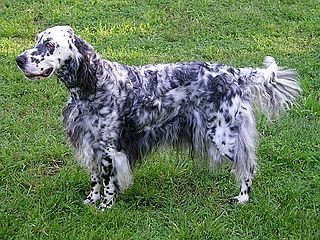 W
WThe setter is a type of gundog used most often for hunting game such as quail, pheasant, and grouse.
 W
WA spaniel is a type of gun dog. Spaniels were especially bred to flush game out of denser brush. By the late 17th century, spaniels had been specialized into water and land breeds. The extinct English Water Spaniel was used to retrieve water fowl shot down with arrows. Land spaniels were setting spaniels—those that crept forward and pointed their game, allowing hunters to ensnare them with nets, and springing spaniels—those that sprang pheasants and partridges for hunting with falcons, and rabbits for hunting with greyhounds. During the 17th century, the role of the spaniel dramatically changed as Englishmen began hunting with flintlocks for wing shooting. Charles Goodall and Julia Gasow (1984) write that spaniels were "transformed from untrained, wild beaters, to smooth, polished gun dogs."
 W
WThe Teddy Roosevelt Terrier is a small to medium-sized American hunting terrier. It is lower-set, with shorter legs, and is more muscular with heavier bone density than the related American Rat Terrier. Much diversity exists in the history of the Teddy Roosevelt Terrier breed, and it shares a common early history with the American Rat Terrier, Fox Paulistinha, and Tenterfield Terrier. The Rat Terrier's background is said to stem from the terriers or other dogs that were brought over by early English and other working-class immigrants. Since the breed was a farm, hunting, and utility dog, little to no planned breeding was used other than breeding dogs with agreeable traits to each other to produce the desired work ethic in the dog. The Feist (dog), Bull Terrier, Smooth Fox Terrier, Manchester Terrier, Whippet, Italian Greyhound, the now extinct English White Terrier, Turnspit Dog, and Wry-legged Terrier all share in the Teddy Roosevelt Terrier's ancestry. These early ratting terriers were then most likely bred to the Beagle or Beagle crossbred dogs and other dogs. Maximizing the influences from these various breeds provides the modern Teddy Roosevelt Terrier with a keen sense of awareness and prey drive, an acute sense of smell. and a very high intellect. Although they tend to be aloof with strangers, they are devoted companion dogs with a strong desire to please and be near their owners at all times.
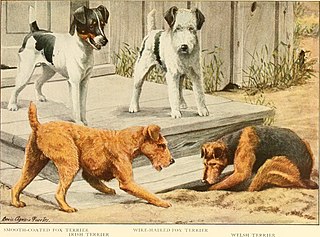 W
WTerrier is a type of dog originally bred to hunt vermin. A terrier is a dog of any one of many breeds or landraces of the terrier type, which are typically small, wiry, game, and fearless. Terrier breeds vary greatly in size from just 1 kg (2 lb) to over 32 kg and are usually categorized by size or function. There are five different groups of Terrier, with each group having different shapes and sizes.
 W
WTreeing is a method of hunting where dogs are used to force animals that naturally climb up into trees, where they can be assessed or shot by hunters. The idiomatic phrase "Barking up the wrong tree" comes from this practice.
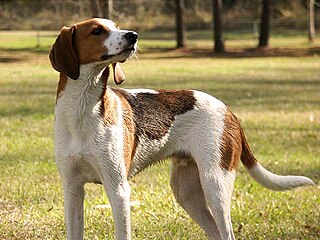 W
WThe Treeing Walker Coonhound is a breed of hound descended from the English and American Foxhounds. The breed originated in the United States when a dog known as "Tennessee Lead" was crossed into the Walker Hound in the 19th century. The Treeing Walker Coonhound was recognized officially as a breed by the United Kennel Club in 1945 and by the American Kennel Club in 2012.
 W
WThe Trigg Hound is a variety of the American Foxhound, developed in Kentucky by Colonel Haiden Trigg.
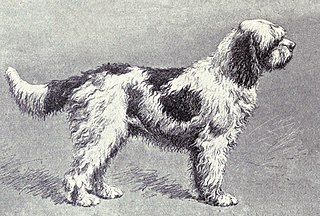 W
WA water dog is a type of gundog bred to flush and retrieve game from water. Water dogs are considered the progenitors of most modern retriever dog breeds.
 W
WThe West Siberian Laika or WSL, is a breed of spitz–type hunting dog. Russian publications indicate that the term West Siberian Laika loosely applied to hunting dogs originating with the Mansi and Khanty people in Ural and West Siberia, but there were no standards or registrations of WSL as such until 1930. Then WWll disrupted it for a while, but systematic breeding with registrations resumed after the war ended, in 1946. This was the time the breed began taking modern shape. Before that hunters only knew of Mansi Laika and Khanty Laika. In early 1960 many hunters in Ural still preferred the term Mansi Laika, when speaking of West Siberian Laika. In Russian language, the term Laika originated from the word layat that means to bark. The word Laika simply means barker. Any hunting Laika is a bark pointer. It is a versatile dog depending on use and environment, but in certain parts of the country they have become more specialized.
 W
WA working terrier is a small type of dog which pursues its quarry into the earth. According to the Oxford English Dictionary, the name dates back to at least 1440, derived from French chien terrier 'digging dog', from Medieval Latin terrarius, ultimately from Latin terra (earth).
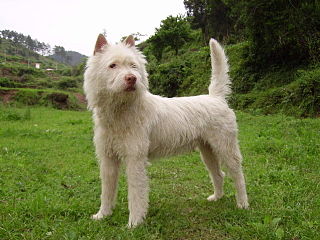 W
WXiasi Dog is a breed of dog originating from Guizhou Province in China. Since the breed is mainly raised in the town of Xiasi, Kaili city, the official name for this breed is Xiasi Quan, though members of the Miao ethnic group also refer to this breed as Bai Long Quan.